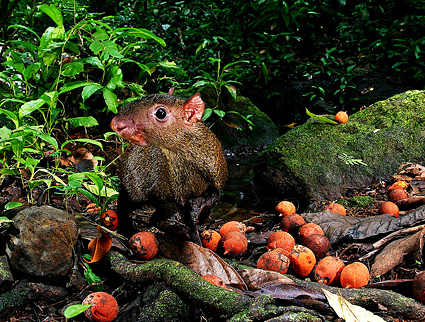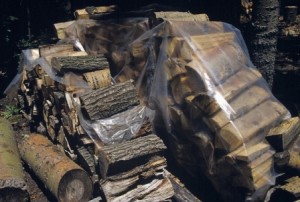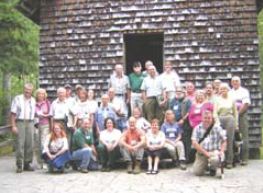
An agouti with the black palm tree’s orange fruit, which contains large seeds.
There’s no honor among thieves when it comes to rodent robbers—which turns out to be a good thing for tropical trees that depend on animals to spread their seeds.
Results of a yearlong study in Panama, published online in Proceedings of the National Academy of Sciences the week of July 16, suggest that thieving rodents helped the black palm tree survive by taking over the seed-spreading role of the mighty mastodon and other extinct elephant-like creatures that are thought to have eaten these large seeds.

Dr. Roland Kays
“The question is how this tree managed to survive for 10,000 years if its seed dispersers are extinct,” says Roland Kays, a zoologist with North Carolina State University and the North Carolina Museum of Natural Sciences. “There’s always been this mystery of how does this tree survive, and now we have a possible answer for it.”
The study showed that agoutis, rainforest rodents that hoard seeds like squirrels, repeatedly stole from their neighbors’ underground seed caches. All that pilfering moved some black palm seeds far enough from the mother tree to create favorable conditions for germination.
“We knew that these rodents would bury the seeds but we had no idea that there would be this constant digging up of the seed, moving it and burying it, over and over again,” says Kays, a member of the Smithsonian Tropical Research Institute team. “As rodents steal the same seed many, many times, it adds up to a long-distance movement of the seed that one animal by itself could have never done.”
One seed was buried 36 times before an agouti dug it up and ate it. About 14 percent of the seeds survived until the following year.
The study, funded with a National Science Foundation grant, caught the furry thieves in the act via individual tags on agoutis, video surveillance of seed caches and tiny motion-activated transmitters attached to more than 400 seeds.
Applying such sophisticated animal tracking techniques to the plant world has the potential to improve scientists’ understanding of forest ecology and regeneration, Kays says.
“When you think about global climate change and habitats shifting, for a forest to move into new areas, trees need to have their seeds moved into new areas. This opens up a route to study how animals can help trees adjust to climate change through seed dispersal.”
Kays, a faculty member with NC State’s College of Natural Resources, was part of an international team that included scientists from Ohio State University and institutions in the Netherlands, Belgium, the United Kingdom and Germany.
– ford –
Media Contacts:
Dr. Roland Kays, roland_kays@ncsu.edu or via Skype at roland.kays
D’Lyn Ford, News Services, 919/513-4798 or 919/480-9493 dlyn_ford@ncsu.edu
Note to editors: An abstract of the paper follows.
“Thieving Rodents as Substitute Dispersers of Megafaunal Seeds”
Authors: Patrick A. Jansen, Smithsonian Tropical Research Institute, Centre for Ecosystem Studies -Wageningen University, Center for Ecological and Evolutionary Studies-University of Groningen; Ben T. Hirsch, Smithsonian Tropical Research Institute, School of Environment and Natural Resources-Ohio State University; Willem-Jan Emsens, Centre for Ecosystem Studies-Wageningen University, Ecosystem Management Research Group-Department of Biology-University of Antwerp; Veronica Zamora-Gutierrez, Centre for Ecosystem Studies-Wageningen University, Department of Zoology, University of Cambridge; Martin Wikelski, Smithsonian Tropical Research Institute, Max Planck Institute for Ornithology; Roland W. Kays, Smithsonian Tropical Research Institute, North Carolina Museum of Natural Sciences, North Carolina State University
Published: Online the week of July 16, 2012, in Proceedings of the National Academy of Sciences
Abstract: The Neotropics have many plant species that seem to be adapted for seed dispersal by megafauna that went extinct in the late Pleistocene. Given the crucial importance of seed dispersal for plant persistence, it remains a mystery how these plants have survived more than 10,000 years without their mutualist dispersers. Here we present support for the hypothesis that secondary seed dispersal by scatterhoarding rodents has facilitated the persistence of these largeseeded species. We used miniature radio transmitters to track the dispersal of reputedly megafaunal seeds by Central American agoutis, which scatter-hoard seeds in shallow caches in the soil throughout the forest. We found that seeds were initially cached at mostly short distances and then quickly dug up again. However, rather than eating the recovered seeds, agoutis continued to move and recache the seeds, up to 36 times. Agoutis dispersed an estimated 35 percent of seeds for >100 m. An estimated 14 percent of the cached seeds survived to the next year, when a new fruit crop became available to the rodents. Serial video-monitoring of cached seeds revealed that the stepwise dispersal was caused by agoutis repeatedly stealing and recaching each other’s buried seeds. Although previous studies suggest that rodents are poor dispersers, we demonstrate that communities of rodents can in fact provide highly effective long-distance seed dispersal. Our findings suggest that thieving scatter-hoarding rodents could substitute for extinct megafaunal seed dispersers of tropical large-seeded trees.






